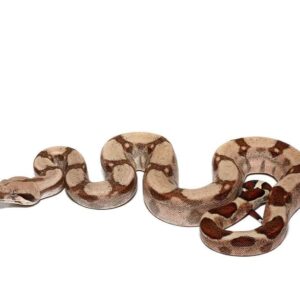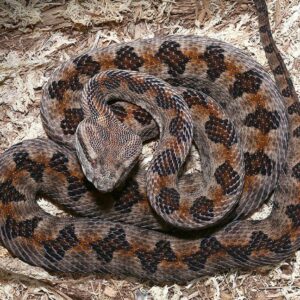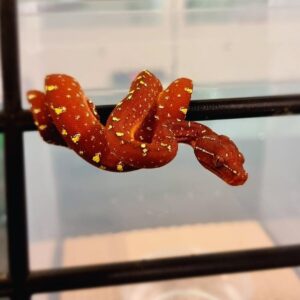Aru Green Tree Python For Sale
$522.99
Aru Green Tree Python
WE HAVE ARU GREEN TREE PYHONS FOR SALE. HERE ARE SOME HIGHLIGHTS:
Aru Green Tree Python
- Morelia viridis
- Farm Bred
- Approximately 20 Inches In Length
- This Species Is Known For Their Beauty And Making Awesome Display Animals
- Nocturnal Hunters That Are Feeding On Live Or Frozen/Thawed Adult Mice
- Originating From Indonesia, Southwest Of New Guinea From The Aru Island
- Adults Can Grow Up To 4-6 Feet In Total Length
- With Proper Care These Can Live Up To 15-20 Years
- This Arboreal Species Will Dangle Their Tail As A Lure To Attract Prey
- Strictly Arboreal Snakes Spending Their Entire Lives In Trees
Aru Green Tree Python eat small mammals and other reptiles, such as frogs, birds, lizards, and bats, especially those found in trees. They are also known to eat ground-dwelling rodents1. They use their sense of smell to locate prey and are excellent climbers. As juveniles, they are diurnal and more active during the day. They are obligate ambush predators and will lure prey close by wiggling the tip of their tail, mimicking a worm, before striking and constricting their prey. When kept as pets, they are often fed a diet that primarily consists of rats and mice
Description
The Aru Green Tree Python, scientifically identified as Morelia viridis, is a captivating species within the reptile community. Distinguished by its vivid green coloration, this python has become an emblematic presence among herpetologists and reptile enthusiasts alike. The lush, emerald hue of the Aru Green Tree Python serves not only as a striking visual feature but also as a critical adaptation for its arboreal lifestyle, blending seamlessly with the dense foliage of its natural habitat.
Native to the Aru Islands, a group of islands in Indonesia, the Aru Green Tree Python thrives in tropical rainforests. These islands provide a perfect environment with high humidity and abundant vegetation, which are essential for the python’s survival. The Aru Green Tree Python is an adept climber, spending the majority of its life coiled around branches. This arboreal behavior is supported by its slender, muscular body and prehensile tail, which allows the python to navigate the forest canopy with ease.
Aside from its remarkable physical characteristics, the Aru Green Tree Python also plays a vital role in its ecosystem. As a predator, it helps to maintain the balance by controlling the populations of small mammals, birds, and reptiles. This ecological contribution underscores the significance of the Aru Green Tree Python within its native habitat.
In the reptile community, the Aru Green Tree Python is highly regarded not only for its beauty but also for its relatively docile nature. This has made it a popular choice among reptile collectors and breeders. However, its captive care requires specific conditions to mimic its natural environment, emphasizing the importance of proper husbandry practices.
Understanding the unique features and ecological importance of the Aru Green Tree Python enhances our appreciation for this extraordinary species. As we continue to explore and study these remarkable creatures, we gain deeper insights into the intricate web of life within tropical ecosystems and the critical role each species plays within it.
Physical Characteristics and Morphology
The Aru Green Tree Python (Morelia viridis) is renowned for its striking appearance, characterized predominantly by its vivid green coloration. This vibrant hue, which provides excellent camouflage among the foliage of its natural habitat, is often interspersed with an array of blue, white, or yellow markings. These markings can vary significantly between individuals, adding to the species’ visual diversity and making each python uniquely captivating.
In terms of size, the Aru Green Tree Python exhibits moderate dimensions. Adults typically achieve lengths ranging from 4 to 6 feet, with females generally being larger than males. Their bodies are slender yet muscular, designed to support their arboreal lifestyle. The scale structure of this species is smooth, enhancing their sleek, streamlined appearance and reducing friction as they navigate through trees.
A distinctive feature of the Aru Green Tree Python is its prehensile tail, which functions as an adept tool for climbing and anchoring. This tail is highly flexible and strong, allowing the python to secure itself firmly onto branches while exploring its environment. This adaptation is particularly advantageous for an arboreal species, facilitating efficient movement and stability within the canopy.
Another intriguing aspect of this species is the morphological differences observed between juveniles and adults. Juvenile Aru Green Tree Pythons often display a dramatically different coloration compared to their adult counterparts. Hatchlings emerge in hues of bright yellow, red, or orange, adorned with irregular patterns. As they mature, these young pythons undergo a gradual transformation, with their juvenile colors fading and the characteristic green adult coloration developing over time.
This ontogenetic color change is thought to provide juveniles with a form of protective camouflage, blending with the forest floor’s leaf litter, where they often reside. As they grow and ascend into the trees, their coloration shifts to suit their new arboreal environment, exemplifying the adaptive versatility of the Aru Green Tree Python.
Natural Habitat and Distribution
The Aru Green Tree Python (Morelia viridis) is predominantly found in the dense rainforests of the Aru Islands, an archipelago located in eastern Indonesia. These islands provide an ideal habitat for the species, characterized by a tropical climate with high humidity and consistent rainfall throughout the year. The lush vegetation offers ample canopy cover, which is essential for the arboreal lifestyle of the Aru Green Tree Python. These rainforests are rich in biodiversity, providing a variety of prey items such as small mammals, birds, and reptiles that are crucial for the snake’s diet.
The climate in the Aru Islands is typically warm, with temperatures ranging from 24 to 30 degrees Celsius. This stable, warm environment supports the python’s thermoregulatory needs. The dense foliage and high trees in these rainforests serve as both a hunting ground and a refuge, making the Aru Islands an optimal environment for the species’ survival and reproduction. The undergrowth and leaf litter also play vital roles, offering hiding spots for juveniles and aiding in the python’s camouflage.
While the Aru Green Tree Python is primarily associated with the Aru Islands, occurrences of the species have been documented in other parts of New Guinea and nearby islands. These secondary habitats share similar environmental conditions, including tropical rainforests with comparable climate and vegetation. However, the density of the population in these areas tends to be lower, possibly due to differences in prey availability and habitat structure.
Outside its primary range, the Aru Green Tree Python has also been observed in some captive breeding programs worldwide. These programs aim to mimic the snake’s natural habitat by maintaining high humidity levels and providing ample climbing structures. While these artificial environments can support the species, they often lack the complexity and ecological interactions found in the wild, underscoring the importance of conserving the natural rainforests of the Aru Islands.
Behavior and Lifestyle
The Aru Green Tree Python, known for its striking emerald coloration, exhibits a distinctive arboreal lifestyle. Primarily inhabiting the dense rainforests of the Aru Islands, this species is highly adapted to life in the trees. Its prehensile tail allows it to navigate through branches with ease, providing stability and maneuverability as it moves in search of prey or suitable resting spots.
As a nocturnal predator, the Aru Green Tree Python is most active during the night. Under the cover of darkness, it employs a sit-and-wait hunting strategy, relying on its excellent camouflage to blend seamlessly with the foliage. This ambush technique allows the python to conserve energy while waiting for unsuspecting prey to wander within striking distance. Its diet primarily consists of small mammals, birds, and occasionally reptiles. Juvenile pythons tend to feed on smaller prey, such as insects and small amphibians, until they grow large enough to tackle bigger targets.
Camouflage plays a crucial role in the survival of the Aru Green Tree Python. Its green scales mirror the leaves of its arboreal habitat, rendering it nearly invisible to both predators and prey. This effective disguise is complemented by its ability to remain motionless for extended periods, further reducing the likelihood of detection. When threatened, the python may adopt a defensive posture, coiling tightly and displaying its brightly colored underbelly as a warning to potential predators.
Unique behavioral traits of the Aru Green Tree Python include its ability to thermoregulate by moving between sunlit and shaded branches. This behavior ensures that the snake maintains an optimal body temperature for digestion and overall metabolic function. Additionally, the python’s solitary nature means that it seldom interacts with others of its kind outside of the breeding season.
Understanding the behavior and lifestyle of the Aru Green Tree Python offers valuable insights into its ecological role and the adaptations that have enabled it to thrive in its specific niche. The interplay of its arboreal habits, nocturnal hunting, and camouflage strategies underscores the complexity and elegance of this fascinating reptile.
Reproduction and Lifespan
The reproductive cycle of the Aru Green Tree Python is a captivating process that underscores the unique aspects of this species. Mating generally occurs during the cooler months, typically from late September to December. During this period, males exhibit increased activity as they search for receptive females. Courtship involves physical contact, where the male uses his spurs to stimulate the female. Once mating is successful, females will undergo a gestation period of approximately 60 days before laying eggs.
Unlike many other reptilian species, the Aru Green Tree Python demonstrates a remarkable level of parental care. Females lay clutches of 10 to 25 eggs, often in a secluded and secure location. Post-laying, the female coils around the eggs, providing both protection and thermoregulation. This brooding behavior is crucial for maintaining an optimal incubation temperature, which typically ranges from 82 to 88 degrees Fahrenheit. The incubation period lasts about 50 to 70 days, after which the hatchlings emerge.
Hatchlings of the Aru Green Tree Python display striking colors, often in shades of yellow or red, which gradually transition to the vibrant green hues characteristic of adults. This color change occurs over a period of six to twelve months. Young pythons are independent from birth, receiving no further care from their mother once they hatch. They are equipped with the instinct and ability to hunt small prey, such as insects and small reptiles, which supports their rapid growth during the early stages of life.
The typical lifespan of the Aru Green Tree Python varies between wild and captive environments. In the wild, these pythons can live for about 10 to 15 years, facing natural predators and environmental challenges. However, in captivity, where they are provided with optimal care and a consistent food supply, their lifespan can extend up to 20 years or more. This longevity in captivity is attributed to the controlled environments that mitigate many of the risks present in the wild.
Conservation Status and Threats
The Aru Green Tree Python (Morelia viridis) is a species of significant ecological and conservational interest. Despite its striking appearance and ecological value, it faces numerous challenges that threaten its survival. Currently, the conservation status of the Aru Green Tree Python is of concern, although it has not been classified as endangered on the IUCN Red List. However, the species is subject to several threats that could impact its population numbers if not properly managed.
One of the primary threats to the Aru Green Tree Python is habitat destruction. The natural habitats of these pythons, particularly the rainforests of the Aru Islands and parts of New Guinea, are increasingly being encroached upon by logging and agricultural activities. Deforestation for timber and the expansion of palm oil plantations pose significant risks, leading to the fragmentation of their habitat and reducing the areas where they can safely live and reproduce.
Climate change also presents a looming threat to the Aru Green Tree Python. Changes in temperature and precipitation patterns can affect the delicate balance of their forest ecosystem. As a species that relies on specific environmental conditions, shifts in climate can lead to habitat degradation and reduced availability of prey, which in turn can affect their survival rates.
The pet trade is another considerable threat to the Aru Green Tree Python. These visually appealing snakes are highly sought after in the exotic pet market, leading to over-collection from the wild. Unsustainable harvesting can significantly deplete local populations, making it challenging for the species to maintain viable numbers in their natural habitats.
Conservation efforts are underway to address these threats and protect the Aru Green Tree Python. Various organizations and local communities are actively involved in initiatives aimed at preserving the species and its habitat. Legal protections, such as restrictions on the international trade of wild-caught individuals, are in place to mitigate the impact of the pet trade. Additionally, habitat conservation projects focus on preserving and restoring rainforest ecosystems, while educational programs raise awareness about the importance of protecting these unique pythons.
Collaboration between conservation organizations, government agencies, and local communities is crucial in ensuring the long-term survival of the Aru Green Tree Python. Through concerted efforts, it is hoped that this fascinating species will continue to thrive in its natural habitat, contributing to the biodiversity and ecological richness of the regions it inhabits.
The Aru Green Tree Python in Captivity
Keeping the Aru Green Tree Python in captivity requires a deep understanding of their natural habitat and specific needs. These vibrant reptiles, native to the Aru Islands of Indonesia, thrive in high-humidity environments with ample foliage. To mimic their natural surroundings, a spacious vertical terrarium with plenty of climbing branches and perches is essential. The enclosure should be maintained at a humidity level between 70-80% and a temperature gradient from 78-88°F. Using a combination of under-tank heating and overhead basking lights can help achieve these conditions.
Feeding an Aru Green Tree Python involves offering appropriately-sized prey items, typically rodents, on a bi-weekly basis. It’s crucial to ensure the prey is no larger than the widest part of the snake’s body to avoid regurgitation and other health issues. Freshwater should always be available, and the water bowl should be large enough for the python to soak in, as they occasionally submerge themselves to aid in shedding.
Handling the Aru Green Tree Python should be approached with care and respect. While they are not inherently aggressive, they can be defensive, especially when young. Regular, gentle handling can help them acclimate to human interaction. However, it’s advisable to limit handling to avoid undue stress. Always wash hands thoroughly before and after handling to prevent the transfer of oils or pathogens.
Common health issues to watch for include respiratory infections, parasites, and shedding problems. Regular veterinary check-ups with a reptile specialist can help prevent and address these concerns. Monitoring the python for signs of illness, such as wheezing, lethargy, or abnormal shedding, is vital for early intervention and treatment.
Ethical considerations are paramount when keeping an Aru Green Tree Python. Responsible pet ownership includes providing a suitable environment, understanding the python’s needs, and committing to their care for their entire lifespan, which can exceed 20 years. Captive-bred specimens are preferable to ensure the conservation of wild populations and to support ethical breeding practices.
Interesting Facts and Myths
The Aru Green Tree Python is a captivating species that has intrigued both scientists and reptile enthusiasts for years. Native to the Aru Islands of Indonesia, this snake is renowned for its vibrant green coloration, which helps it blend seamlessly into its arboreal habitat. However, beyond its striking appearance, there are several fascinating facts and enduring myths surrounding this enigmatic reptile.
One of the most intriguing aspects of the Aru Green Tree Python is its remarkable color transformation. Juveniles are typically bright yellow or red, gradually changing to vibrant green as they mature. This color shift is believed to provide better camouflage against predators at different stages of their life cycle. Additionally, these pythons possess heat-sensing pits along their jawline, allowing them to detect warm-blooded prey even in complete darkness.
In local folklore, the Aru Green Tree Python is often revered and sometimes feared. Some tribes believe that these snakes possess mystical powers, acting as guardians of the forests. Stories abound of pythons guiding lost travelers back to safety or serving as omens of impending events. While these tales add to the snake’s mystique, they also contribute to various myths about its behavior and abilities.
One common myth is that the Aru Green Tree Python is highly aggressive and prone to attack humans. In reality, this species is generally shy and prefers to avoid confrontation. When threatened, it may display defensive behaviors such as coiling tightly or hissing, but it rarely bites unless provoked. Another misconception is that these pythons are venomous; in fact, they are non-venomous constrictors, relying on their powerful muscles to subdue prey.
The popularity of the Aru Green Tree Python among reptile enthusiasts cannot be overstated. Its stunning coloration and relatively manageable size make it a sought-after species in the pet trade. However, potential owners should be aware of the specific care requirements, including a controlled environment that mimics their natural habitat. Despite their beauty, these pythons are not beginner pets and require knowledgeable handling and care.
By shedding light on the intriguing facts and debunking common myths, we can better appreciate the Aru Green Tree Python for the extraordinary creature it is. Whether observed in the wild or kept as a pet, this species continues to captivate and inspire awe among all who encounter it.






